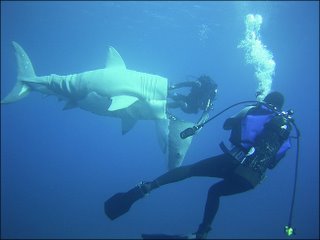Wacky scientists are hot, I tell you. Hot.
Ocean Explorer Becomes One With the Sharks

There have been many men inside sharks through the ages, but only one has wanted to be there, and his name is Cousteau.
The familiar name carries with it a well-established sense of seawater, science and showmanship. But this Cousteau is Fabien, the 38-year-old grandson of Jacques and an ocean explorer in his own right.
Fabien Cousteau is studying the behavior of great white sharks. They have gotten an unfair reputation as soulless killers, he said in an interview. Reading stories about shark attacks, he said, "It struck me about how much misinformation about sharks is out there." With a new documentary that will be shown on CBS later this year, he's out to show that they are, well, not exactly cuddly, but not evil either.
One problem with monitoring sharks, he said, is that it is so hard to observe them without affecting their behavior. The shark cages, the bait - it all adds up, he said, to footage of gaping mouths and churning water foamed with blood.
The idea for a shark submarine came to him, he said, from the adventures of Tintin, a comic strip character created by a Belgian artist. In "Red Rackham's Treasure," Tintin explores the sea in a shark-shaped sub. "I was 7 years old when I read it," said Mr. Cousteau, who was born in Paris but lives in New York.
He named his submersible Troy, for another animal-shaped vehicle with invaders inside. Piloting the 14-foot craft was not a joy. "Troy is definitely not for the claustrophobic!" he wrote in an e-mail message after the interview. He compared the experience to "being in a womb."
The interior is filled with water, and he uses a rebreather. He carried six hours of air on each dive, but would usually become uncomfortably chilled after a couple of hours.
Mr. Cousteau's gamble paid off, he said, when the groups of sharks he approached off the coasts of Mexico allowed him to cruise along with them. "The sharks were willing to be around us," he said. He found that some - perhaps not the brightest of the bunch - were apparently fooled by the swimming fake.
"The fact that it even remotely worked, remotely resembled a swimming shark, was really neat," he said.

Aucun commentaire:
Enregistrer un commentaire